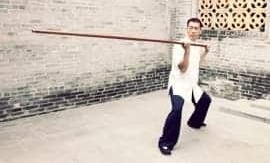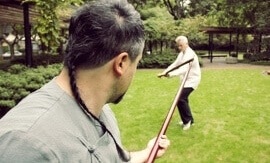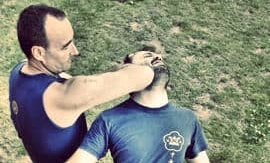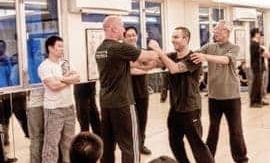
SIFU ALTON MILLER IS A DESCENDANT OF THE YUEN KAY SAN/SUM NUNG WING CHUN LINEAGE. PERHAPS IT WAS INEVITABLE THAT HE WOULD STUDY MARTIAL ARTS. IN THE 1930s, HIS GRANDFATHER STUDIED AIKIDO IN JAPAN—A DECADE IN WHICH MORIHEI UESHIBA WAS STILL DEVELOPING THE ART.
Sifu Miller met Lee Chun Ming in 1974—a meeting that marked the start of a lifetime in Wing Chun. His 45+ years living the art includes several trips to China and Hong Kong, training with Sigung Kwok Wan Ping and Yuen Kay San’s only disciple, Sijo Sum Nung.
What made you interested in studying Wing Chun?
In the late 1960s, I studied Shorin-Ryu Karate and later Tien Shan Pai Kung Fu. I wanted to study Wing Chun because of Bruce Lee. That was it.
My Sifu moved to Washington D.C. in 1973 and I met him the following year. Besides the Wing Chun, my Sifu taught me Dragon, Hung Gar, White Eyebrow and Seven-Star Mantis Kung Fu.
In 1974, Sifu was teaching Wing Chun at George Washington University in Washington D.C. Although, we changed locations several times and my Sifu returned to Hong Kong in the early 1990s, we’ve had a school in Northern Virginia ever since. Our current school, Canton Wing Chun, has been in Fairfax, Virginia, since 1999.
Tell us about your trips to China and Hong Kong, and what was it like meeting your Sijo, Sum Nung?
I’ve made several trips to China with my Sifu, and some without. The first trip was in 1975 when I met Sijo. Sijo told my Sifu I was to practise only Wing Chun and not to focus on any of the previous arts he (my Sifu) had studied.
Sum Nung didn’t speak English, so the interpretations went through my Sifu. He was always relaxed and he looked like a normal, older gentleman. You couldn’t tell Sum Nung was the Grandmaster of Yuen Kay San Wing Chun, but when he touched you—you knew! When you touched hands with him, you could feel his power and control. It was precise and to the point. Direct, no fooling around, he would shut you down.
What was it like training with your Sigung, Kwok Wan Ping?
When Sum Nung touched you, you felt the energy of Wing Chun. It’s the same with Kwok Wan Ping and my Sifu. They feel similar but different, and I learned from them all. Sigung had trained in many different martial arts, including wrestling, he was very muscular.
What was it like training with your Sifu, Lee Chun Ming?
When I met my Sifu, he had only been training for a few years, but he was exceptionally good. He felt different from Sijo and Sigung. When my Sifu touched you, it was like being in heavy water.
The first Wooden Dummy techniques he taught me were Jip/Tan/Gum Sao. These techniques taught me the importance of sticking and I used to practice them over and over again.
The training was different back in the 1970s. We worked on stances and basic techniques for months. We used to start the basic warm-up with 100 repetitions of the basics (Lan Sao, Lap Sao, Tan Sao, Gan Sao, etc.), including several different kicks. Then, we did 100 punches with everybody in the class. Then we used to go outside and run a mile and back from school. This was just the warm-up!
Initially, there were very few students and I became a co-instructor early on. My Sifu felt teaching was the best way to learn and knew that by watching and correcting another student’s techniques, you are improving your own.
What is the forms curriculum at the school?
We practise the Yuen Kay San/Sum Nung version of the 50 three empty-hand forms Sil Lum Tao, Chum Kiu and Bil Jee. We practise the Wooden Dummy form and have empty-hand versions of the Dummy form. For weapons, we have Lok Dim Boon Kwun (“6 1⁄2 Point Pole”), Baat Jam Surn Do (“Butterfly Knives”) and Jong Do, which is the entire Wooden Dummy form using the Knives. I developed the Jong Do form and it’s unique to our school.
What are the most important attributes to be developed through Wing Chun training?
Wing Chun is an effective system to learn self-defence. The more you train, the less you rely on physical force. We use the minimum amount of energy to attain maximum efficiency.
As soon as you make contact, the “First Touch”, you take control at that moment. That’s the only way you can shut someone down. You can’t do that against a high-level student if you rely on physical strength. You have to be relaxed and able to change at the moment contact is made.
It’s the journey—it takes years of training to separate breathing from movement, being able to change at any moment, know how to absorb and redirect… the forms, Wooden Dummy and two-person sets will help you with this.
Every technique has a counter. No technique is better than the next technique. Anybody can learn the entire Wing Chun system in a year, at least know the movements. But are they good? No. If you want to be good, then you need to have the feel in Wing Chun and that takes years to develop. That’s why you can’t learn Wing Chun from books or videos; you need to find a credible master and be in a class to feel the art.
Everything complements everything in Wing Chun. Everything makes sense. If it doesn’t make sense, it’s not Wing Chun.
If Grandmaster Yuen Kay San were alive today, what would you ask him?
I was in awe when I met my Sifu for the first time, the same and more when I met Sigung and Sijo. Although I wouldn’t ask, they would show me techniques. Whatever they say or demonstrate is very important and has meaning. It would be the same with Yuen Kay San. I wouldn’t ask, but I would love to see him work the Wooden Dummy and demonstrate the forms. I would also like to talk to him about Cheung Bo’s 12-Form Hand techniques. Just to be in the presence of someone like Yuen Kay San would be a lesson itself.
How would you like to see Canton Wing Chun continue to pass on the Yuen Kay San lineage to future generations?
That’s happening every day because of the mentorship programme and the constant influx of new students. It used to be like a pyramid, where my Sifu was at the top, then me. But, we didn’t have as many advanced students in the 1970s.
Now, it’s more like a structure being built from the ground up and each layer continues to spread out. The art itself—the legacy is from Yuen Kay San and Sum Nung. If I hadn’t been taught by my Sifu, Sigung and Sijo, the legacy would’ve ended when my Sifu returned to Hong Kong in the early 1990s.
Over the years, I’ve organised a curriculum with techniques/forms/ applications introduced in a specific order at each sash level. We’re open five days a week and have about 150 students, many have been with us for decades. I’ve never tried to expand and we don’t advertise, yet we continue to have new students every month. The system is in place and if the past 45 years is any indication, I believe that the interest will continue for years to come.



















